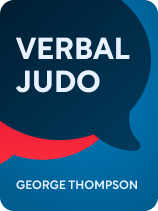

This article is an excerpt from the Shortform book guide to "Verbal Judo" by George Thompson. Shortform has the world's best summaries and analyses of books you should be reading.
Like this article? Sign up for a free trial here.
Do you listen more than you talk? What’s your primary goal when you communicate? What can you learn about listening from an octopus?
It probably comes as no surprise that listening well is important. Active listening is a specific skill that’s invaluable in all aspects of life, and it’s part of the practice of Verbal Judo—a set of techniques that help you handle any tense situation calmly.
Read more for George Thompson’s threefold advice on how to improve active listening and communicate more effectively as a result.
Active Listening in Verbal Judo
One significant Verbal Judo technique is to put as much effort into your listening as you do into your talking. Thompson advises using a technique called active listening. This kind of listening involves not only listening purposefully to the other person, but staying open to what they have to say and communicating (verbally and non-verbally) that you’re understanding. In Verbal Judo, Thompson shares practical advice on how to improve active listening so you can communicate more effectively.
(Shortform note: Experts consider listening an active, rather than passive, skill: one where you use verbal and nonverbal communication to make everyone feel heard. But active listening isn’t natural or comfortable for everyone. Often, neurotypical people learn to make direct eye contact, sit still, nod, and respond with facial expressions when they listen. That’s not necessarily true for neurodivergent people, whose brains develop, learn, or process information in ways that aren’t considered “typical.” They don’t necessarily show that they’re listening in the same way, but that doesn’t mean they aren’t engaged. Experts say we should learn each other’s communication styles and body language so everyone feels understood in the way they communicate.)
1. Ask Them to Explain
Going into a tense conversation, you might have some context to work with. But, when you need to know how someone is thinking or feeling, ask them! Thompson explains that active listening can involve asking open-ended questions about what’s happening, what their opinions are, and how they’d like the problem to be solved. As you listen, try to do so without jumping to conclusions or being influenced by preconceived notions.
2. Ask Whether You’re Understanding Correctly
Active listening doesn’t require intuiting what the other person means: When you state a person’s complaint back to them, you can also ask if you’re understanding correctly. This question gives you a practical way to ensure you know what’s happening. And it clearly shows the other person that you’re trying to understand them. This can help them dial things back: They’ll still be frustrated or angry, but they’ll be more likely to cooperate with you to resolve the argument or problem.

———End of Preview———
Like what you just read? Read the rest of the world's best book summary and analysis of George Thompson's "Verbal Judo" at Shortform.
Here's what you'll find in our full Verbal Judo summary:
- How to handle any tense situation calmly
- How you can persuade even the angriest person to cooperate
- The three most important verbal judo principles






